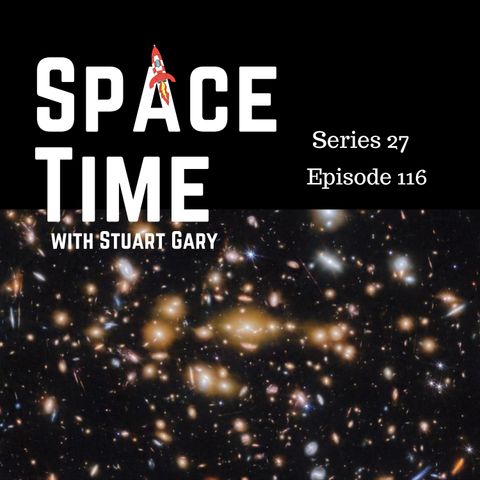Transcribed
S27E116: Unexpected Black Hole Abundance, Io's Volcanic Surprise, and W Boson Precision
Sep 25, 2024 ·
25m 33s

Download and listen anywhere
Download your favorite episodes and enjoy them, wherever you are! Sign up or log in now to access offline listening.
S27E116: Unexpected Black Hole Abundance, Io's Volcanic Surprise, and W Boson Precision
Description
SpaceTime Series 27 Episode 116 *Discovery of More Black Holes Than Expected in the Early Universe A new study using the Hubble Space Telescope has uncovered a significantly higher number...
show more
SpaceTime Series 27 Episode 116
*Discovery of More Black Holes Than Expected in the Early Universe
A new study using the Hubble Space Telescope has uncovered a significantly higher number of supermassive black holes in the early universe than previously anticipated. Published in the Astrophysical Journal Letters, the findings could revolutionise our understanding of how these ancient black holes formed shortly after the Big Bang. Astronomers, including Alice Young from Stockholm University, suggest that these massive black holes might have originated from the collapse of massive gas clouds or through rapid mergers of smaller stellar-mass black holes.
*New Volcano Spotted on Jupiter's Moon Io
Astronomers have discovered a new volcano on Io, one of Jupiter's moons, using the Junocam instrument aboard NASA's Juno mission. Io, the most geologically active object in the solar system, boasts over 400 active volcanoes. The newly discovered volcano, located just south of Io's equator, was identified in the first close-up images of Io in over 25 years. The images reveal multiple lava flows and volcanic deposits, with sulphur staining on the eastern side and dark lava streams on the western side.
*Confirming the Mass of the W Boson
Scientists at CERN have confirmed the mass of the W boson, a fundamental particle in physics, to be 80,360.2 mega electron volts, with a margin of error of 9.9 mega electron volts. This confirmation resolves a previous unexpected measurement and aligns with the Standard Model of particle physics. The study utilised data from the Compact Muon Solenoid (CMS) detector at the Large Hadron Collider, involving the analysis of millions of events to achieve this precise measurement.
www.spacetimewithstuartgary.com
www.bitesz.com
This week’s guests include: Alice Young from Stockholm University
🌏 Get Our Exclusive NordVPN deal here ➼ www.bitesz.com/nordvpn. The discount and bonuses are incredible! And it’s risk-free with Nord’s 30-day money-back guarantee! ✌
Become a supporter of this podcast: https://www.spreaker.com/podcast/spacetime-with-stuart-gary--2458531/support.
Support our sponsors and help support SpaceTime - Thank you:
Protonmail - for when email security is paramount. Setup and start for free!
Malwarebytes (as recommmended by Alex Zaharov-Reutt in the Tech Report)
Old Glory - Iconic Music and Sports Fam Memorbillia & Merch.
show less
*Discovery of More Black Holes Than Expected in the Early Universe
A new study using the Hubble Space Telescope has uncovered a significantly higher number of supermassive black holes in the early universe than previously anticipated. Published in the Astrophysical Journal Letters, the findings could revolutionise our understanding of how these ancient black holes formed shortly after the Big Bang. Astronomers, including Alice Young from Stockholm University, suggest that these massive black holes might have originated from the collapse of massive gas clouds or through rapid mergers of smaller stellar-mass black holes.
*New Volcano Spotted on Jupiter's Moon Io
Astronomers have discovered a new volcano on Io, one of Jupiter's moons, using the Junocam instrument aboard NASA's Juno mission. Io, the most geologically active object in the solar system, boasts over 400 active volcanoes. The newly discovered volcano, located just south of Io's equator, was identified in the first close-up images of Io in over 25 years. The images reveal multiple lava flows and volcanic deposits, with sulphur staining on the eastern side and dark lava streams on the western side.
*Confirming the Mass of the W Boson
Scientists at CERN have confirmed the mass of the W boson, a fundamental particle in physics, to be 80,360.2 mega electron volts, with a margin of error of 9.9 mega electron volts. This confirmation resolves a previous unexpected measurement and aligns with the Standard Model of particle physics. The study utilised data from the Compact Muon Solenoid (CMS) detector at the Large Hadron Collider, involving the analysis of millions of events to achieve this precise measurement.
www.spacetimewithstuartgary.com
www.bitesz.com
This week’s guests include: Alice Young from Stockholm University
🌏 Get Our Exclusive NordVPN deal here ➼ www.bitesz.com/nordvpn. The discount and bonuses are incredible! And it’s risk-free with Nord’s 30-day money-back guarantee! ✌
Become a supporter of this podcast: https://www.spreaker.com/podcast/spacetime-with-stuart-gary--2458531/support.
Support our sponsors and help support SpaceTime - Thank you:
Protonmail - for when email security is paramount. Setup and start for free!
Malwarebytes (as recommmended by Alex Zaharov-Reutt in the Tech Report)
Old Glory - Iconic Music and Sports Fam Memorbillia & Merch.
Information
| Author | bitesz.com |
| Organization | bitesz.com |
| Website | www.spacetimewithstuartgary.com |
| Tags |
Copyright 2024 - Spreaker Inc. an iHeartMedia Company
